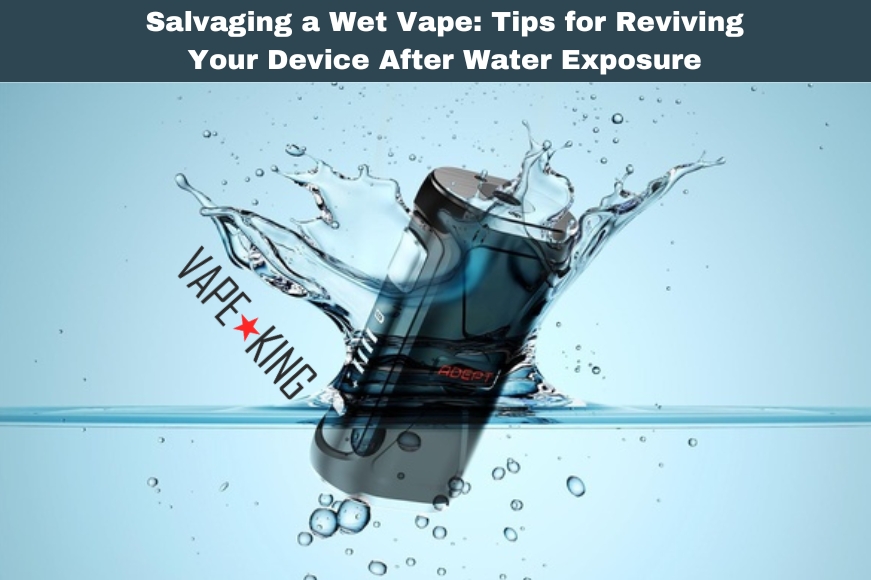Salvaging a Wet Vape: Tips for Reviving Your Device After Water Exposure

Your vape is likely your constant companion, accompanying you wherever you go. Consequently, encountering situations where dropping your device in water is a possibility is not uncommon. If this has happened to you, don't fret; it's a mishap that occurs to many individuals at some point.
However, dropping a vape in water poses a significant risk due to the incompatibility of water with electronic components. The likelihood of permanent damage to the device is high. Yet, in some cases, there may be a chance to revive a submerged vape rather than discarding it altogether. In this article, we'll provide some tips that could potentially assist you in resurrecting your vape. Additionally, we'll introduce some innovative water-resistant vapes aiming to mitigate water-related accidents effectively.
What Happens When Your Vape Encounters Water?
When a vape comes into contact with water, the immediate course of action is to remove it promptly from the water. Unless equipped with specific waterproofing measures, moisture will infiltrate the device's interior rapidly.
Water poses two primary threats to vapes and electronic devices:
1. Electrical Conductivity: Water, even with impurities, can conduct electricity, increasing the risk of a short circuit. This risk is particularly high given the presence of dissolved minerals in most water sources. Attempting to use a vape immediately after water exposure could render the device permanently inoperative due to potential short-circuiting.
2. Corrosion: Prolonged exposure to water can lead to corrosion of the device's internal metal components. While corrosion may not manifest immediately, it could cause erratic behavior or complete device failure weeks or months later.
Given these risks, there are three crucial steps to take when a vape comes into contact with water:
1. Immediate Removal: Swiftly extract the device from the water to minimize moisture ingress. Acting promptly may prevent water from contaminating the internal electronics.
2. Avoid Usage: Refrain from using the device to prevent potential short circuits. If the vape features a removable battery, remove it and leave the battery compartment open to facilitate airflow.
3. Thorough Drying: Extract excess water from both the interior and exterior of the device as much as possible. Further details on this step will be discussed shortly.
Water-Resistant Vapes: A Solution to Accidental Water Exposure
Did you know that certain vape kits boast water-resistant properties? Certain Vape devices adhere to the IP67 standard for ingress protection, enabling them to withstand immersion in water up to a meter deep for 30 minutes.
As mentioned earlier, occasional accidents are inevitable when your vaping device is your constant companion. By opting for devices fortified against environmental hazards, such as water-resistant vapes, you can alleviate concerns about potential accidents and focus on enjoying your vaping experience.
How to Salvage a Vape After Water Exposure
If you've inadvertently dropped your vaping device in water, swift action is paramount. As previously advised, the immediate priority is to prevent a short circuit by promptly removing the device from the water. If the device features a removable battery, detach it and leave the battery compartment open.
For devices with detachable tanks or pods, remove them and set them aside. If necessary, clean these components by rinsing them in clean water and allowing them to air dry. Since tanks and pods lack electronic components, concerns about short circuits are mitigated. Complete disassembly of the vape is recommended to encourage airflow through the device.
Once you've disassembled the device as much as possible, the next step is to manually eliminate excess water. Use paper towels to blot the device's surface and dry the battery compartment if applicable. For pod systems, dry the chamber atop the device after removing the pod. If the vape features a removable battery, ensure the battery compartment is thoroughly dried.
To expel water from disposable vapes effectively, blowing through the device's air intake hole while covering the bottom intake hole with a paper towel can prove effective. This method helps dislodge water trapped inside the device.
Drying the Device Completely: Ensuring Optimal Moisture Removal
Following the aforementioned steps offers the best chance of salvaging your vape, as much of the water inside the device should have been removed by now. However, it's advisable to refrain from using the device immediately, as residual moisture may remain in its interior. Before resuming vaping, it's crucial to place the device in an environment conducive to moisture evaporation. To achieve this, consider employing a moisture-absorbing substance.
While rice is commonly suggested as a desiccant in online resources, some argue its effectiveness is overstated. Rice may impede airflow and prove less efficient at moisture absorption than presumed. Alternatively, silica gel packets, known for their superior moisture-absorbing properties, offer a reliable solution. These packets, often found in new electronic device packaging can be purchased online or in home improvement stores.
If desiccant packets are unavailable, some silica gel-based cat litters can serve as effective substitutes. Simply place the device in a container filled with silica gel or cat litter, periodically redistributing the substance to facilitate moisture absorption.
Regardless of the method chosen, ensure the device remains in the designated environment for approximately 24 hours to allow complete drying. Once dry, and if no short circuits occurred during water exposure, the vape should be ready for use as usual.
By following these steps, you can increase the likelihood of salvaging your vape after accidental water exposure, potentially saving you the expense of replacing the device.
No posts found
Write a review


